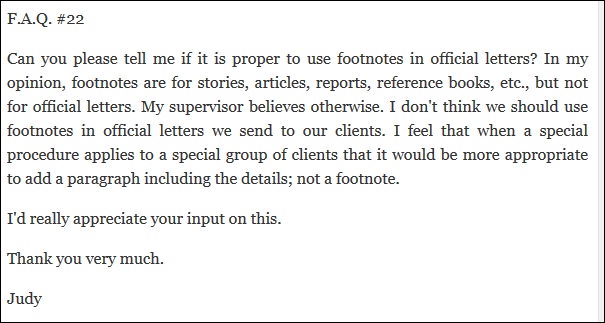Footnotes and Official Letters
Updated on / dernière mise à jour : 12/14/2023

Answer
There are two dimensions that we must consider in regard to your question:
1) the theoretical use of footnotes; and
2) the context in which such footnotes would be used.
Let's start with the use of footnotes in theory. Footnotes can (and should) be used:
1) whenever you include a quote taken directly from another author's book or article;
2) whenever you include one or many statistics (kilometers for a military frontage, number of victims in a conflict, amount of money given by a government, etc.);
3) whenever a very precise idea or group of ideas are taken directly and literally from another author's argumentation;
4) whenever you include supplementary information allowing you to define or illustrate in more details a concept included to your text.
Hence, in pure theory, whenever one of the previous four situations occur (and for any kind of document, official or not), a footnote could be used.
Now, since you're telling me that the document is an official letter sent to a special group of individuals, it is important for the sender of the document to understand (and remember) that its clientele may be composed of very different individuals: some of them are intellectuals, others are not; some of them may have difficulties reading official documentation while others may be literate; etc. Because of this diversity and, notably, the fact that the government and private companies have the obligation to ensure that their information is easy to read and comprehend, it is also my opinion that an additional paragraph including extra information on the special procedure be used.
This being said, let's not forget that official letters are not necessarily exempt of reference notes since such notes should be applied when one of the four previous situations occurs. It is up to you and your supervisor to decide if the inclusion of footnotes in the official document could lead some of your clients to misunderstand or misinterpret parts or all of the special procedure. It is true that footnotes are written, usually, in smaller letters and that being at the bottom of the page (footnote) or at the end of the document (endnote) may lead some people not to read it whereas a distinct paragraph within the document would be hard to miss.
So, in regard to supplementary information (the fourth situation mentioned above) included to an official public document, it is best – for this particular case – to do as you initially thought and include another paragraph. But, in regard to the three other situations, you should also include footnotes if required because it is important for the public to know where the sources of the information originate from (quotes from another book; statistics and/or another author's argumentation).
In a way, you are both right: you may need to use footnotes except for supplementary information which would appear in another distinct paragraph. If stats, quotes and/or arguments from a third party are not present then no footnotes are needed for this type of public document.





